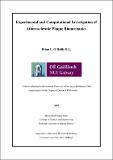| dc.contributor.advisor | McGarry, Patrick | |
| dc.contributor.author | O'Reilly, Brían L. | |
| dc.date.accessioned | 2020-05-08T14:27:57Z | |
| dc.date.available | 2020-05-08T14:27:57Z | |
| dc.date.issued | 2019-11-22 | |
| dc.identifier.uri | http://hdl.handle.net/10379/15952 | |
| dc.description.abstract | The overall objective of this thesis is to provide new insights into the composition and biomechanical behaviour of atherosclerotic plaque. Experimental and computational analysis techniques are developed to investigate the morphological distributions and mechanical behaviour of calcified particles and fibrous tissue in excised carotid and femoral plaque samples. Finite element simulations are performed to analyse the influence of plaque and calcification morphology and lumen gain following stent deployment. Additionally, cohesive zone models are implemented to predict the modes of plaque rupture during standard balloon angioplasty and cutting balloon angioplasty.
Experimental testing reported in Chapter 4 presents a novel investigation of the morphological and mechanical properties of human iliofemoral and carotid atherosclerotic plaque constituents. Micro-computed tomography analysis is used characterize the content and morphology of calcifications in excised plaques. The largest calcified particle contributes most of the total calcification in the plaque. Unconfined compression testing of isolated calcifications uncover viscoelastic behaviour and tensile stress relaxation uncovered viscoelastic behaviour in fibrous atherosclerotic samples. Iliofemoral fibrous samples are found to be significantly stiffer than carotid fibrous samples. Results show isolated calcifications are significantly stiffer than non-calcified fibrous tissue.
Utilising this experimental characterisation data, the effects of calcification volumes on balloon angioplasty and stenting are explored in Chapter 5. The effects of calcification on stenting and balloon angioplasty biomechanics are investigated to potentially assist optimisation of atherosclerosis treatment. Implementing finite element methods, balloon expansion is simulated in stenosed arteries with various calcification content and geometries. It is shown that the balloon pressure to achieve full patency increases with
ii
increasing calcification volume. The presence of circumferentially aligned calcifications results in a higher balloon pressure in comparison to longitudinally aligned calcifications. High strains are calculated in fibrous tissue where it is in series with calcification in the circumferential direction and in the thinnest section of fibrous tissue. Eccentric plaque models with varying calcification content are stented using two stents of different strut thicknesses. The highest maximum principal strains are predicted at the connecting struts at the distal and proximal ends of the stenosis.
Large strains computed during the balloon deployments motivated the investigation of the mechanisms of plaque rupture in Chapter 6. Cohesive zone formulations are used to model fibrous plaque tissue fracture and delamination at the fibrous tissue-calcification interface and at the fibrous plaque tissue-artery interface. Simulations reveal that the mechanism of rupture is intra-fibrous tissue crack propagation in the radial direction through the thinnest section of the plaque. The consequent release of strain energy from the plaque following such rupture eliminates the occurrence of delamination of calcified particles from the fibrous tissue or delamination of the plaque from the artery wall. Simulations also reveal that cutting-balloon angioplasty reduces the pressure required for rupture if one of the blades is positioned at the thinnest section of the plaque. Otherwise, the introduction of cuts into the fibrous tissues is predicted to increase the pressure required to cause rupture. | en_IE |
| dc.publisher | NUI Galway | |
| dc.rights | Attribution-NonCommercial-NoDerivs 3.0 Ireland | |
| dc.rights.uri | https://creativecommons.org/licenses/by-nc-nd/3.0/ie/ | |
| dc.subject | Biomechanics | en_IE |
| dc.subject | Atherosclerosis | en_IE |
| dc.subject | Stenting | en_IE |
| dc.subject | Arterial Mechanics | en_IE |
| dc.subject | Cohesive Zone | en_IE |
| dc.subject | Science and Engineering | en_IE |
| dc.subject | Engineering | en_IE |
| dc.subject | Biomedical engineering | en_IE |
| dc.title | Experimental and computational investigation of atherosclerotic plaque biomechanics | en_IE |
| dc.type | Thesis | en |
| dc.contributor.funder | College of Engineering and Informatics, National University of Ireland, Galway | en_IE |
| dc.local.note | Human atherosclerotic tissue is mechanically tested and micro-CT scanned to generate accurate material and geometric data as inputs for accurate computational models. The generated data is implemented in stenting and angioplasty models to investigate the performance and safety of these interventions on both calcified and non-calcified plaques. | en_IE |
| dc.local.final | Yes | en_IE |
| nui.item.downloads | 292 | |


